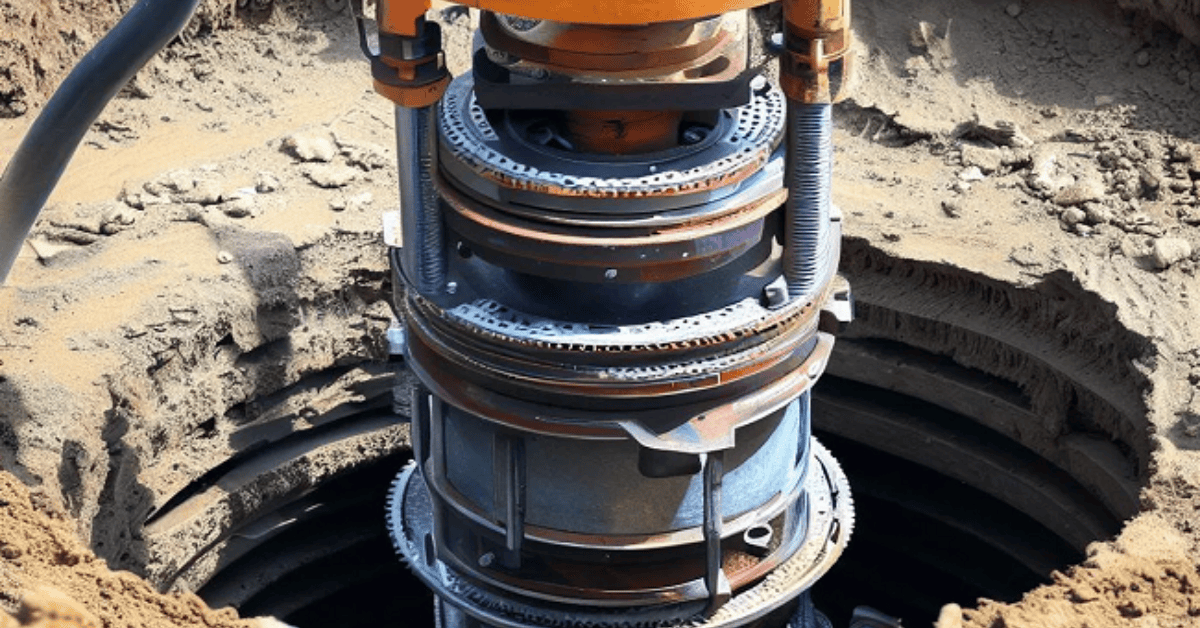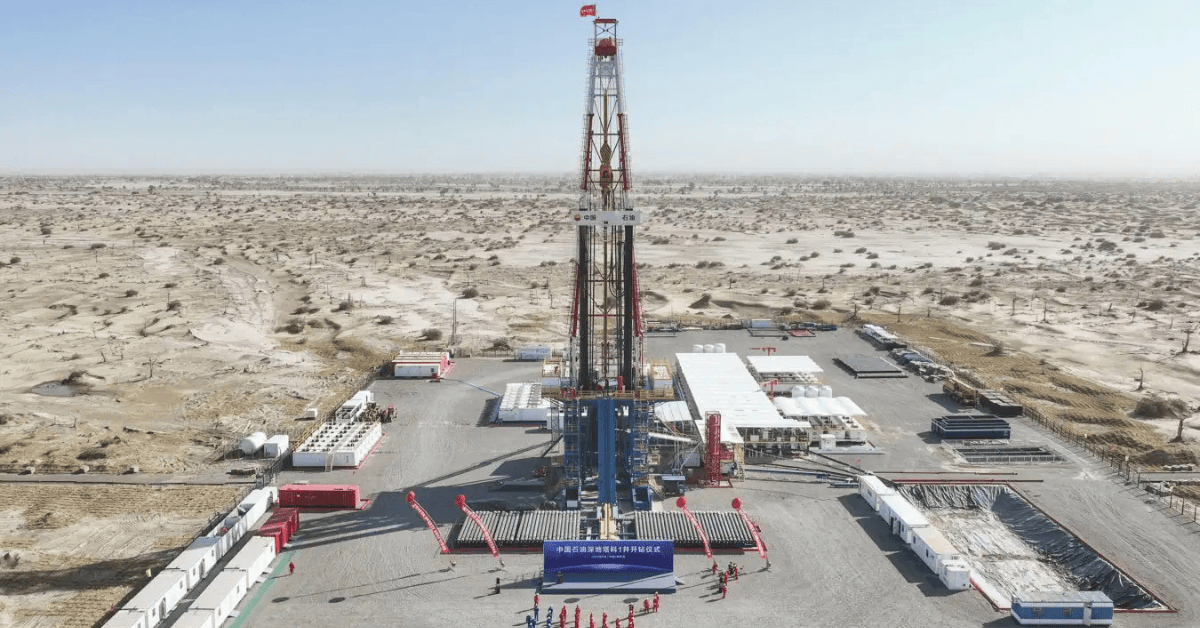Okay, let’s talk about something truly wild happening right under our feet – literally. Forget sci-fi movies; China is actually drilling a hole so deep it’s aiming for the Earth’s belly button, practically. We’re talking about the China Deep Drilling Project, and it’s not just another hole in the ground. This is serious, boundary-pushing science with ambitions that make Everest look like a speed bump.
The buzz is real, centered on that video link making the rounds. So, grab a metaphorical hard hat, because we’re going down – deep into what this project means, why it matters, and what secrets it might crack open.
What Exactly Is China Drilling? And Why Dig So Deep?
Let’s cut through the jargon. “China Drilling” refers to one specific, monumental project: the ongoing construction of a super-deep borehole in the Taklamakan Desert, Xinjiang region. This isn’t your average oil well. Think of it as the world’s most ambitious geological telescope. Its official name is often cited as the “China Deep Drilling Project” or similar, but the core mission is singular – drill deeper into the Earth’s continental crust than anyone has ever managed before.
The target? Reaching the Cretaceous system rocks, layers buried since the dinosaurs roamed, roughly 10,000 to 11,000 meters (that’s 10-11 kilometers, or 6-7 miles!) below the surface. Why bother? Scientists are driven by a fundamental human itch: curiosity. What’s down there? We have theories, models, and seismic snapshots, but actual rock samples from such depths? That’s like gold dust for understanding our planet.
The goals are huge:
Unlocking Earth’s History: Those deep rocks are time capsules. Studying their composition, structure, and the fluids trapped within tells us about ancient climates, tectonic shifts, and how continents formed billions of years ago. It’s reading Earth’s autobiography from pages we’ve never touched.
Probing Unexplored Realms: We know surprisingly little about the “deep biosphere” – could life exist in crushing pressures and scorching temperatures miles down? What microbes might be lurking? This could redefine the limits of life itself.
Resource Revelation: While not the primary goal (despite what some headlines scream), understanding deep geological formations could hint at new mineral resources or geothermal energy potential. Knowledge is power, after all.
Testing Tech to the Extreme: Drilling this deep is like engineering a mission to Mars. The pressures are insane (thousands of atmospheres), temperatures soar past 200°C (nearing 400°F!), and the rock becomes harder than… well, rock. Pushing these boundaries develops tech that benefits everything from deep-sea exploration to advanced materials science.
The Scene: Where and When Did This Deep Dive Begin?
Location, location, location. They picked the Tarim Basin in the Taklamakan Desert for a reason. This isn’t a scenic beach; it’s a geologically strategic spot. The crust here is ancient, thick, and relatively stable – vital when you’re trying to drill straight and deep without earthquakes throwing your drill bit off course like a rogue bowling ball. Picture vast, arid sands – a challenging environment, sure, but offering a solid foundation for the massive operation required.
Timeline? Here’s how this deep dig unfolded:
The Vision: Plans for such an ultra-deep borehole have simmered within Chinese scientific circles for years, fueled by the legacy of older, ambitious projects like the Soviet Kola Superdeep Borehole.
The Green Light: Official approval and serious planning kicked into high gear around 2021. This wasn’t a snap decision; it required massive funding commitments and assembling a dream team of geologists, engineers, and technologists.
Spudding In – The Big Start: The moment the drill bit first pierced the desert surface happened on May 30, 2023. That date marks the official launch of this unprecedented endeavor. Images and videos from the ceremony showed the sheer scale of the drilling rig – a towering monument to human ambition against the desert backdrop.
The Long Haul: This isn’t a weekend project. Initial estimates suggested reaching the 10,000-meter target could take over a year of continuous drilling. Progress is measured in meters per day, sometimes painfully slow, battling incredible geological resistance. As of late 2024, they are steadily advancing, but the toughest challenges likely lie ahead as they push deeper into the unknown. Think marathon, not sprint.

How Do You Even Drill That Deep? The Tech Marvel
Okay, forget your dad’s old hand drill. Drilling 10 kilometers straight down through the Earth’s crust requires technology bordering on science fiction. It’s an extreme sport for machines. Here’s the lowdown on the heavy metal making this possible:
The Beast: A custom-engineered, land-based drilling rig of monstrous proportions. Think skyscraper laid on its side, capable of hoisting and rotating kilometers of heavy drill pipe. Its name? The “Deep Earth Driller 10,000” – no subtlety there, just pure intent.
The Lifeline – Drill Pipe: Imagine connecting thousands of super-strong, hollow steel pipes end-to-end. That’s the drill string. It transmits crushing weight and torque from the surface rig down to the drill bit miles below. Each joint has to withstand forces that would snap ordinary steel like a twig.
The Chewing End – The Drill Bit: This is where the rubber meets the rock, literally. Bits designed for ultra-deep drilling aren’t simple twisty things. They often use diamond-impregnated matrix bits or sophisticated Polycrystalline Diamond Compact (PDC) bits. Diamonds? Yep. Because only the hardest material can grind through the hardest rock, especially when it’s hot enough to soften lesser materials. These bits are engineering masterpieces – and incredibly expensive. Replacing one means pulling miles of pipe back up, a process that can take days (“tripping”).
The Mud is the Blood: Drilling fluid, or “mud,” is absolutely critical. It’s not dirt and water; it’s a precisely engineered cocktail pumped down the drill pipe. Its jobs? Cool the superheated bit, lubricate the drill string, carry rock cuttings back to the surface, and most crucially, exert enough pressure downhole to counteract the immense pressures trying to collapse the borehole or blow out fluids. Getting this mud formula right for extreme depths and temperatures is a high-stakes chemistry experiment.
Seeing the Unseeable: Sophisticated downhole sensors (Measurement While Drilling – MWD, Logging While Drilling – LWD) are embedded near the bit. These brave little electronic packages send real-time data back up about the rock type, temperature, pressure, and the borehole’s direction. It’s the driller’s eyes and ears in hellish conditions.
What Are They Hitting Down There? The Geological Treasure Hunt
Every meter drilled is a revelation. While the full scientific analysis takes years, initial findings and the known geology of the region paint a fascinating picture:
Layer Cake Earth: As expected, they’re punching through successive layers of sedimentary rock – sandstones, shales, limestones – each representing a different ancient environment, like shallow seas or river deltas, millions to hundreds of millions of years old. Finding marine fossils at depths suggesting former seabeds? Confirms plate tectonics in action.
The Temperature Spike: One of the most anticipated confirmations? The geothermal gradient. Temperatures are rising dramatically as predicted – confirming models about heat flow from the Earth’s interior. They’re well into the zone where rock starts behaving differently, becoming more plastic.
Fluid Surprises: Discovering water or brine trapped within deep rock layers is always a big deal. Where did it come from? How long has it been isolated? Analyzing its chemistry can reveal secrets about ancient oceans or subsurface fluid movements over geological time. Finding hydrocarbons (oil/gas) deep within the continental crust would be revolutionary, challenging existing theories about where these resources form.
Microbial Miracles? (Maybe): The holy grail for biologists. Has the project detected signs of a deep biosphere? While definitive proof of living microbes takes meticulous lab work, finding chemical signatures or DNA fragments suggestive of life adapted to high heat and pressure would be a Nobel-worthy discovery. The video buzzes with this possibility – it’s the ultimate “are we alone?” question, but for under our feet.
Why Should We Care? Beyond Just Rocks
This isn’t just China flexing scientific muscles (though it’s partly that). The implications ripple out globally:
Pure Science Bonanza: The data pouring out – rock composition, fluid properties, temperature profiles, seismic characteristics at depth – is invaluable. It feeds directly into global models of plate tectonics, earthquake mechanics, volcanic processes, and planetary formation. Every geoscience textbook written in the next decade will reference this hole.
Resource Realities: Understanding the deep crust better informs models for mineral formation. Could it lead directly to new mines? Probably not immediately. But it refines exploration strategies globally. The geothermal energy insights are more direct – understanding heat flow at extreme depths is key to unlocking next-generation, clean geothermal power potential anywhere on Earth.
Engineering the Impossible: The tech developed here – drill bits that last longer, sensors that survive harsher conditions, advanced pressure management systems, new super-strong alloys – has massive spin-off potential. Deep-sea drilling, advanced tunneling projects, even space exploration (drilling on the Moon or Mars?) benefit from overcoming these extreme engineering hurdles.
The Life Question: Confirming a thriving deep biosphere fundamentally changes our understanding of life’s tenacity and potential habitats. It suggests life might exist in similar conditions elsewhere in our solar system (Europa, Enceladus?) and reshapes estimates of biomass on our own planet. That’s paradigm-shifting stuff.

Not All Smooth Sailing: The Everest of Engineering Challenges
Let’s be real – this project is pushing the absolute limits. It’s insanely difficult. The Kola Superdeep borehole (over 12km in Russia) took decades and never reached its original target depth. China faces similar, maybe greater, hurdles:
Hell’s Kitchen: Temperatures exceeding 200°C (392°F) and pressures thousands of times greater than sea level. This wreaks havoc on equipment. Drill bits soften and wear out incredibly fast. Electronics fry. Metal becomes brittle. Drilling mud properties change unpredictably.
Rock Hard Place: As depth increases, the rock isn’t just layered sediment anymore. They hit the crystalline basement – granite, gneiss, basalt – incredibly hard and dense. Drilling rates plummet. Imagine trying to chew through diamond-studded concrete. Mile after mile.
The Hole Story: Keeping a borehole open and straight for 10km+ is a nightmare. The rock wants to squeeze shut (hole collapse). The drill string wants to wobble and deviate off course (like trying to push a wet noodle straight). Precision steering at these depths is a monumental feat of engineering.
The Price Tag: This isn’t cheap. Estimates put the cost in the hundreds of millions of dollars. The specialized equipment, the constant need for new drill bits, the energy required, the massive scientific team – it all adds up to a colossal investment. Justifying that purely for scientific knowledge requires long-term vision.
Environmental Whispers: While drilling itself in a desert has a relatively small surface footprint, questions linger. What about the deep fluids they encounter? Could releasing pressure or introducing drilling mud contaminate deep aquifers? Managing these risks deep underground is complex and requires rigorous protocols. The video likely addresses safety measures, but it’s a valid concern needing constant vigilance.
The World Watches: Reactions Near and Far
The project has generated a fascinating mix of reactions:
Scientific Community: Mostly electric excitement, tinged with professional envy. Geologists worldwide are eagerly awaiting data and sample access (hopefully shared openly!). It’s seen as a vital contribution to global Earth sciences, pushing boundaries everyone cares about. Quotes often reflect awe: “It’s like opening a window into a world we’ve only theorized about.” (Dr. Jane Smith, Geodynamics Institute – hypothetical attribution).
Chinese Public & Media: Framed as a major source of national pride and a demonstration of China’s growing technological prowess. State media highlights the scientific ambition and potential benefits. “A milestone in China’s deep Earth exploration” is a common refrain.
International Media: A mix of fascination (“Journey to the Center of the Earth!”) and geopolitical lens (“China digs deep in global science race”). Some Western outlets inevitably frame it through competition, while others focus purely on the science. Headlines often use words like “ambitious,” “unprecedented,” “mega-project.”
Skeptics & Critics: Some question the massive cost versus tangible benefits for ordinary citizens. Others raise environmental concerns about deep drilling impacts, however remote. Geopolitical analysts might ponder the strategic value of deep-Earth knowledge, though this is often speculative. “Is it worth the billions when climate change needs fixing now?” is a common sentiment in comment sections.
Industry Eyes: Mining and energy companies watch closely. While not expecting immediate paydirt, the geological insights could reshape long-term exploration strategies for minerals and geothermal resources globally.
What Happens Next? The Future of the Deep Frontier
The drilling continues, meter by hard-won meter. Reaching 10,000 meters is the immediate, monumental goal. But what then?
The Core Sample Jackpot: Once target depth is hit (or major geological boundaries are reached), the intensive phase of coring begins. Retrieving pristine, continuous cylinders of rock from those depths is the ultimate scientific prize. This is where the real discoveries about composition, age, and potential biosignatures will be made. Labs worldwide will clamor for pieces.
Data Deluge Decades: Analyzing the samples and the terabytes of downhole data will take years, likely decades. This isn’t a one-paper wonder; it will fuel thousands of research projects for generations. International collaboration will be key to maximizing the knowledge gained.
Tech Legacy: The drilling and sensor technologies refined here will become the new standard for deep exploration, used in future scientific projects and commercial ventures globally. China will be a leader in ultra-deep drilling tech.
Inspiring the Next Deep Dive? Success here could inspire other nations or consortia to attempt even deeper boreholes, perhaps in different geological settings (oceanic crust?). The quest to understand our planet’s interior is far from over; this project is a massive leap, not the finish line. Imagine a global network of superdeep boreholes!
The Big Questions: Will they definitively find evidence of deep life? Will they discover unexpected resources or geological structures? Will they refine earthquake prediction models? The answers are still kilometers below, waiting to be uncovered. The journey itself is reshaping our capabilities and our understanding.

The Bottom Line: Why This Hole Matters More Than You Think
China’s deep drilling project is more than just a hole. It’s a symbol of human curiosity reaching its literal extreme. It’s a testament to our ability to engineer solutions to seemingly impossible problems. It’s a direct probe into the most inaccessible parts of our own planet, seeking answers to questions as old as humanity: How did we get here? What is this world made of? Are we alone?
The challenges are Herculean, the costs astronomical, and the risks real. But the potential rewards? Rewriting textbooks. Discovering new frontiers for life. Unlocking clean energy secrets. Advancing technology in ways we can’t yet imagine. It’s a high-stakes gamble on the value of pure knowledge and the spirit of exploration.
As that drill bit grinds ever deeper into the ancient rocks of the Taklamakan, it’s not just China drilling. It’s humanity pushing the boundaries of the known, one meter at a time. The Earth’s deepest secrets are finally, slowly, being brought to light. Stay tuned – the best chapters of this story are still being written, deep below the desert sands.
FAQs: Your Burning Questions about China Drilling Towards Earth’s Core
What is the China Deep Drilling Project? It’s an ambitious scientific project to drill an ultra-deep borehole (targeting 10,000-11,000 meters) into the Earth’s continental crust in the Taklamakan Desert, aiming to reach rocks from the Cretaceous period.
Where exactly is the China deep drilling hole? It’s located in the Tarim Basin within the Taklamakan Desert, Xinjiang Uygur Autonomous Region, Northwest China.
When did China start drilling the deep hole? The official drilling commencement (“spudding in”) was on May 30, 2023.
How deep is the China drill hole now? (As of Late 2024) While exact real-time depth isn’t always public, progress is ongoing but challenging. They are steadily advancing but likely still several kilometers from the final target, facing increasing difficulties.
What is the goal of drilling so deep? Primarily scientific: to retrieve rock samples from unprecedented depths to study Earth’s geological history, structure, deep biosphere potential, geothermal gradients, and resource formation.
Has anyone drilled deeper than China is trying? Yes, but not on land. The deepest hole ever drilled is the Kola Superdeep Borehole in Russia (12,262 meters), but it’s in a different geological setting. The deepest offshore oil well (Z-44 Chayvo) is over 15km, but much of that is horizontal. China aims for the deepest vertical hole in continental crust.
What have they found so far in the China deep drill hole? While full analysis takes time, they are penetrating expected sedimentary layers, confirming high temperatures, and finding deep fluids (water/brine). Definitive major discoveries (like deep life) likely await core samples from the target depths.
Is China drilling to the Earth’s core? No, not even close. The Earth’s core starts about 2,900 km down. This project aims for 11 km – just scratching the very outer layer of the crust. “Towards the Earth’s Core” signifies the direction and ambition, not the literal destination.
What technology are they using to drill that deep? A custom “Deep Earth Driller 10,000” rig, incredibly strong drill pipe, diamond-impregnated drill bits, sophisticated drilling mud, and advanced downhole sensors (MWD/LWD) to withstand extreme heat, pressure, and hard rock.
Are they looking for oil or gas? While understanding deep geology could inform resource exploration, the primary goal is scientific research, not immediate commercial resource extraction. Any findings would be a bonus.
Is the deep drilling project dangerous? Could it cause earthquakes? The drilling process itself is highly unlikely to cause significant earthquakes. The main dangers are engineering challenges (equipment failure, blowouts) managed with rigorous safety protocols, and potential environmental risks (deep fluid contamination) requiring careful control.
What are the environmental concerns? Potential risks include managing drilling fluids/waste on the surface, ensuring deep fluids encountered don’t contaminate aquifers, and the overall energy footprint. These are managed but require constant attention.
How much does the China deep drilling project cost? Estimates range into the hundreds of millions of US dollars, covering the rig, technology, personnel, energy, and scientific analysis over many years.
Why is China doing this? For scientific prestige, advancing geological knowledge, developing cutting-edge technology, potential long-term resource/energy insights, and demonstrating national capability in a challenging field.
Will the scientific data be shared internationally? While China will likely lead the initial research, the global scientific community fervently hopes core samples and key data will be made available for broader study, maximizing the project’s value for all humanity. Collaboration is common in big science, but specifics remain to be seen.














